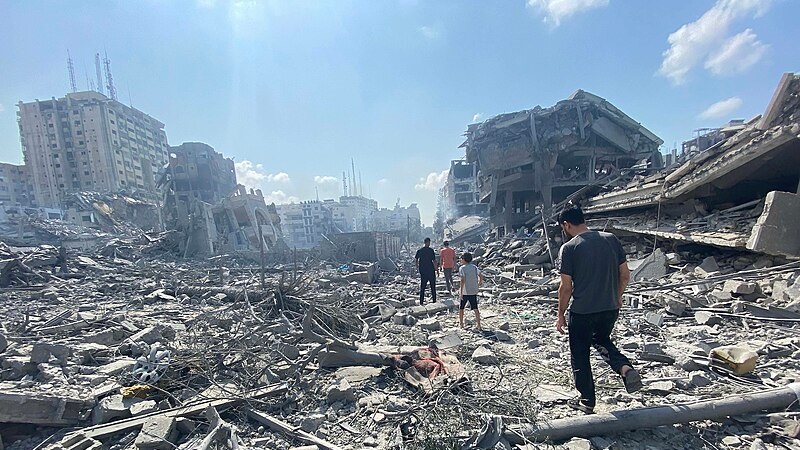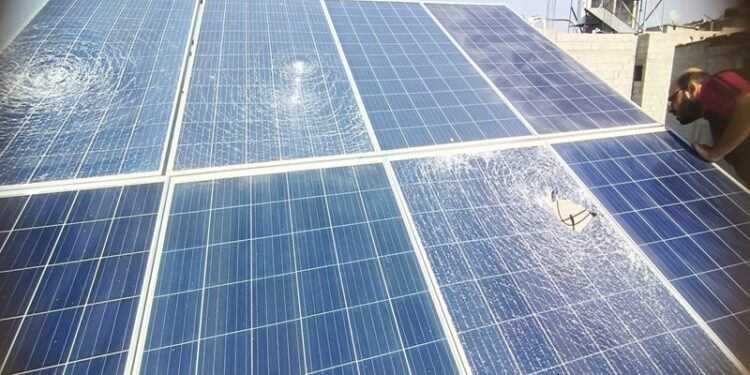As Israel cuts off electricity to the Gaza Strip, rooftop solar panels help residents to survive frequent bombardment
As the Israeli government cuts off fuel supplies to the besieged Palestinian enclave of Gaza, solar panels are providing a lifeline for some of the area’s two million residents.
For years, the region has suffered blackouts which worsen during Israeli attacks and wealthier Gazans have turned to solar panels for reliable electricity.
After Hamas militants invaded Israel on 7 October and massacred over 1,400 civilians, the Israeli defense minister ordered a “complete siege” of Gaza, cutting off electricity and fuel supplies.
Residents of Gaza told Climate Home these solar panels, while still vulnerable to Israeli bombardment, were helping keep the lights on.

Palestinians inspect the damage following an Israeli airstrike on the El-Remal aera in Gaza City on October 9, 2023. (Photo: Naaman Omar apaimages)
Twenty-nine year old Amjad Al-Rais lives in Gaza City, the part of the Gaza Strip which Israeli fighters have attacked the most. He has had solar panels on the roof of his house for five years.
He told Climate Home: “Solar panels are very important to our lives and they are the best option during the current time with the outbreak of war, to produce electricity around the clock without interruption.”
Like many Gazans, Al-Rais had previously relied on fossil fuel generators but said these require a lot of fuel “which is not currently available due to the Israeli blockade”.
Muhammed Al-Yaziji owns a company that sells solar panels in Gaza and said that “there has been a significant demand during the last five years… with the frequent power outages in Gaza”.
Bad in peace, worse in war
For over a decade, Gaza has not had enough electricity to meet its needs, leading to blackouts.
The United Nations says this has “severely affected the availability of essential services, particularly health, water and sanitation services, and undermined Gaza’s fragile economy”.
The electricity that Gazans do have comes partly from a gas-fired power plant and partly from electricity cables from Israel, paid for by the Palestinian authority. Some Gazans supplement this with their own generators or solar panels.
Since Israel cut off supplies, hospitals in Gaza have struggled to provide care to the sick and injured.
This sparked protests from humanitarians. The head of Medical Aid for Palestinians, Melanie Ward, said that 130 premature babies were in danger from the hospital’s lack of electricity.
“The world cannot simply look on as these babies are killed by the siege on Gaza… A failure to act is to sentence these babies to death,” she said.
Prior to the recent explosion of violence, the World Bank attempted to build Gaza’s resilience, offering grants to put solar panels on hospitals and in refugee camps.
No silver bullet
Like other imports to the Gaza Strip, solar panels are subject to Israeli custom duties, pushing up costs.
Anas Abu Sharkh is a 46-year old teacher in Gaza City, who paid $8,000 in installments for eight solar panels.
He said this price which he said was “extremely high” but cheaper than running a generator. The average Gazan earns $13 a day.
Movement mourns ‘driving force for climate justice’ Saleemul Huq
Electricity systems based on rooftop solar are harder for armed groups to destroy than centralised systems based on fossil fuel power plants.
This, along with their falling price, has led to a boom in their use in war-torn countries like Yemen.
But solar panels are not immune from war. Three of Sharkh’s solar panels were damaged by Israeli bombs and Al-Rais said his panels were “subjected to severe damage”.
Source: Climate Change News



Recent Comments